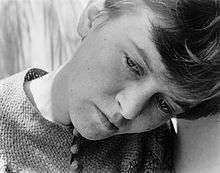Sonya Noskowiak
| Sonya Noskowiak | |
|---|---|
 Sonya Noskowiak, c.1932. Photograph by Imogen Cunningham. | |
| Born |
November 25, 1900 Leipzig, Germany |
| Died |
April 28, 1975 (aged 74) Greenbrae, California, USA |
| Nationality | American |
| Known for | Photography |
Sonya Noskowiak (25 November 1900 - 28 April 1975) was an American photographer and member of the famous San Francisco photography collective Group f/64 that included Ansel Adams and Edward Weston.
Life
Noskowiak was born in Leipzig, Germany. Her father was a landscape gardener who instilled in her an awareness of the land that would later become evident in her photography.[1] In her early years she moved around the world while her father sought work in Chile, then Panama and finally in California. In 1915, the family moved to the Los Angeles basin in California, and in 1919 she moved to San Francisco to enroll in secretarial school.[2] While in San Francisco she began working for photographer Johan Hagemeyer, and he taught her the basics of the trade. Through Hagemeyer she met Edward Weston, and from 1929 to 1935 she lived with him as a lover, student, model, printer of his commercial photographs and surrogate mother to his children. While with Weston she developed a strong vision of her own, and she quickly became known for her portraits and artistic images. She continued taking and selling photographs through the 1950s. In 1965 she was diagnosed with bone cancer, and she died ten years later in Marin County, California.
Photography
It was while working at Johan Hagemeyer's studio in the 1920s that Noskowiak realized her true calling was in photography. But it was not until 1929, when she met Edward Weston, that she began to fully develop her talents. She soon became Weston’s darkroom assistant, and he taught her both the craft and the artistry of the camera. Soon she was turning her lens on architectural subjects and capturing the strong profiles of bridges, lighthouses and water towers. Following Weston’s lead she then began to look at patterns in nature, which she photographed with a distinct style that “suggests the coherence of the natural world.”[3] Dora Hagemeyer (sister-in-law of Johan) wrote that while Noskowiak's photographic style was clean and direct like Weston's, she "put into her work something which is essentially her own: a subtle and delicate loveliness."[4]
In 1932 Noskowiak became an organizing member of the short-lived Group f/64, which included such important photographers as Ansel Adams, Imogen Cunningham, Willard Van Dyke, Weston and his son Brett. Members of f/64 believed that photography was an art form in itself, and so photography did not need to follow the norms of the fine arts in order to be defined as art. Noskowiak's works were shown at Group f/64's inaugural exhibition at San Francisco's M. H. de Young Museum; she had nine photographs in the exhibit – the same number as Weston.[5]
Her photos were eventually shown at various one-woman shows at the Ansel Adams Gallery, the Denny-Watrous Gallery in Carmel, California, and at Willard van Dyke's 683 Gallery in Oakland, California. She was also included in several group exhibitions in Bay Area museums. Noskowiak drifted away from Group f/64 some time in 1934, perhaps when her relationship with Weston frayed and perhaps because other members of the group were going their separate ways.[6]
She went on to record such luminaries of her time as Jean Charlot, John Steinbeck, and Martha Graham. The portrait of Steinbeck is particularly powerful, and is one of only a handful of images of the writer in the 1930s. It is used extensively to this day.
Noskowiak opened her own studio, probably in 1935. In 1936, she was one of eight photographers, including Weston, selected for the California region of the Federal Arts Project. She spent the next year photographing California artists and their paintings, sculptures and murals. These images then toured to a variety of public institutions. Though she continued to photograph as an artist, Noskowiak's livelihood from the 1940s on was based on portraiture, fashion and architectural images. In the years after Edward Weston separated from Charis Wilson and was diagnosed with Parkinson's, he asked Noskowiak to return and resume their former relationship, but she proudly refused.
Noskowiak retired from photography in 1965, and she died in 1975 in Greenbrae, California.
Her archives, including 494 prints, hundreds of negatives and many letters to Edward Weston, are now housed at the Center for Creative Photography in Tucson, Arizona.
Notes
- ↑ Darsie Alexander (2002). Original Sources: Art and Archives at the Center for Creative Photography. Center for Creative Photography. p. 149.
- ↑ Marnie Gillett (1979). Sonya Noskowiak. Center for Creative Photography. p. 4.
- ↑ Edward Weston (1973). The Daybooks of Edward Weston. Aperture. p. 147.
- ↑ Hagemeyer, Dora (8 September 1933). "Noskowiak Exhibit Important to Art". Carmel Pine Cone: 4.
- ↑ Therese Thau Heyman (1992). Seeing Straight: The f.64 Refolution in Photography. Oakland Museum. p. 67.
- ↑ Donna Bender (1979). Sonya Noskowiak Archive, Guide Series 5. Center for Creative Photography. p. 5.